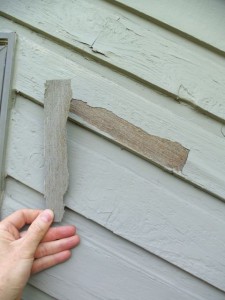Over the years, in our exterior painting work in the Chicago area, Painting in Partnership Inc. has encountered a troubling issue with cedar siding: peeling paint (or stain) that comes off in sheets, all the way down to bare wood on the sunniest side of the house. Additionally, on the back of the paint chips are dead wood fibers embedded in the chip. What is going on here?
This problem is part of an ongoing analysis and investigation we, as house painting contractors, are conducting, in order to provide our clients the best possible results for their paint job. When dead wood fiber is present on a surface, it cannot be successfully painted or stained. Before too long, especially in the areas most exposed to the sun, the coating will massively fail.
There are two issues raised in this last paragraph. First, what caused the dead wood fiber in the first place? There can be several potential reasons, but a common one is exposure to sunlight before the wood is coated for the first time (when the house is first built). The ultraviolet light degrades the lignin and causes cellulose fibers to dry out and causes the wood surface to lose structural integrity. The gray color of the resulting wood fiber is similar to the brown or red tones of sunburn on skin.
The other issue we are dealing with here is: why is “sunburned” wood more susceptible to paint failure, especially on the sunny sides of a house? A paint or stain cannot properly adhere to dead wood fiber. After such wood is coated, the stresses caused by sun on the wood surfaces is such that the coating actually detaches from the substrate, leaving it susceptible to cracking, blistering and complete failure.
How do you deal with the problem: coating removal, partial or complete. The problem with a partial approach is that the coating that does not come off now, will fail later. Depending on the severity of the delaminating, we sometime recommend the complete stripping of the coating. What about the dead wood fiber? It has to be sanded down. Sometimes, the surfaces are so degraded that sanding is not effective. In such cases, we coat the bare wood with a liquid epoxy consolidator, which acts as a replacement for the lignin and binds the wood fibers back together again.
As house painting contractors, we seek to understand the cause of paint failure, so as to prevent future ones from occurring. We call that part of our work as the “forensics of paint failure”.








 Follow
Follow
